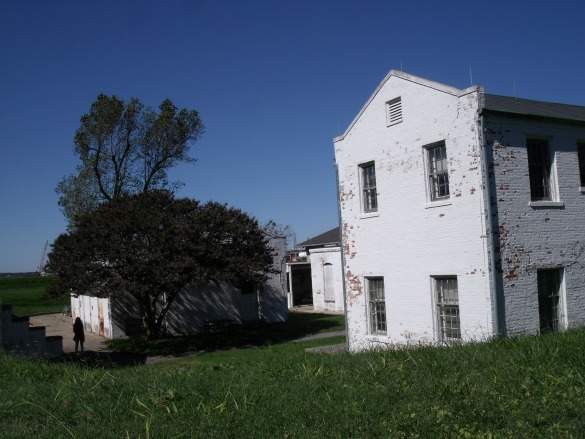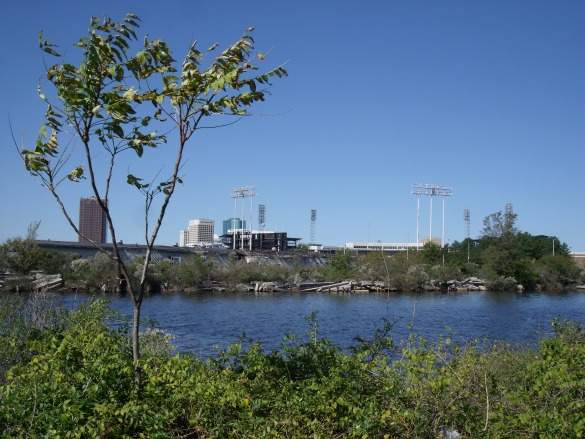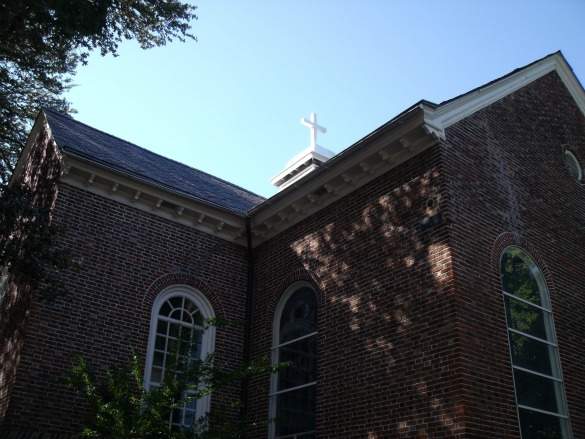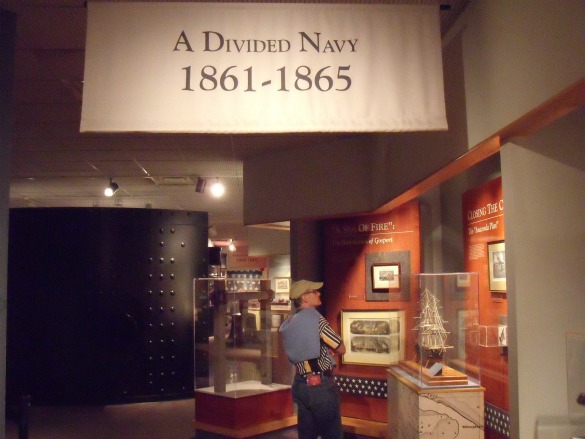“The Tide” is Norfolk’s 7.4 mile long light rail system, where a $3 online pass will buy you unlimited rides for a day. I found it very useful to help me get to some off-the-beaten-path sites that were involved in and/or are related to the years before, during, and after the Civil War. Because the downtown area is easily navigable by foot, I explored more historical gems related to America’s great conflict with my comfortable walking shoes.
Fort Norfolk Has the Feel of Centuries’ Past
I headed northwest of downtown in search of an out of the way former military installation called Fort Norfolk, where wartime activities had taken place there beginning with the American Revolution. It’s just three blocks from the light rail system’s EVMC/Fort Norfolk Station and nestled inside the grounds of the US Army Corp of Engineers (next to a multi-story retirement home). Admission is free, though you many have to show your photo ID if someone is manning the gate.
Fort Norfolk was abandoned by the Rebels in 1862, but not before supplying the ammo used by the South’s CSS Merrimac against the North’s USS Monitor in the great ironclad battle. The Union Army made it a prison and then the fort served as a naval installation until 1878. Brick buildings that have been painted white made me think I was wandering around Santorini. I walked around the buildings, which were surrounded by high grassy mounds, which offered me some great views of the Elizabeth River and dockyards. In the midst of a sunny, breezy day, I could feel the presence of those past centuries long gone.
Some of Virginia’s Underground Railroad Escape Routes Are Near a Baseball Park
The light rail system’s Harbor Park Station leads right up to the Norfolk Tides’ baseball park, where minor leaguers strive to make it to the big leagues each season. But just behind the left field parking lot (southwest of the stadium), a more important game was played out. These were areas where slaves strived to make it to freedom via some Virginia Underground Railroad sites of 150-plus years ago. Conspicuous yet unmarked pathways lead to these unkempt areas where once Higgins’ Wharf and Wright’s Wharf stood, leading to the Elizabeth River. Now fisherman are about the only people who hang around there.
Slaves who could navigate this generally isolated area would be able to secretly board ships sailing for the north, like the Augusta, which charged legal passengers some $7 dollars for passage to New York (meals included) in the mid-nineteenth century, departing Tuesdays, Thursdays, and Saturdays at 6:30 a.m. I found myself feeling isolated while pondering how challenging it would be to risk one’s life to get freedom, having to avoid the pitfalls of ship raids for fugitive slaves and the common knowledge around town, through Abolitionist newspapers, about the city’s role in helping escaped slaves.
Just a few blocks from “The Tide’s” Monticello Station, the Norfolk History Museum at the Willoughby-Baylor House can be found. It was built in 1794, and is free to enter. The city’s history is extensively covered through pictures, maps, and aged artifacts. This includes the occupation of Union forces from 1862-1865. I learned about how whites would be able to evade being drafted by getting African Americans to substitute for them at “Negro substitute” centers, some located in Norfolk. I discovered the violent aftermath when race riots were common after the war’s end, as blacks were striving to assert their new freedoms due to the 1866 Civil Rights Act. And the walls leading up to the second floor contain some really gripping black and white photos of Norfolk’s people and places during the late 19th and early 20th centuries.
Walking Norfolk’s Streets Brought More Civil War History Back to Life
As for getting some good wear on my new athletic shoes, I walked some calories off by when I took a 90 minute Norfolk Walkabouts tour, led by Zack Mansell. It was one beautiful Saturday morning as we sauntered through the Freemason neighborhood, near to the shipyards and docks, just to the northwest of downtown. I strolled down cobblestone lanes lined with sycamore and oak trees, dominated by stately homes where ship’s captains once lived.
Their grand dwellings display many styles of architecture including Federal, Queen Anne, Georgian Revival, etc. At the corner of Botetcourt St. and Freemason St. (the first street in Norfolk with gas lamps), the union used Dr. William B. Seldon’s home as their headquarters. Seldon was the Surgeon General for the Confederates, and would host Confederate General Robert E. Lee after the great conflict in 1870.
For those who are into self-guided tours, I found the Cannonball Trail essential for helping get more intimate with Norfolk. The walk takes explorers to potentially 43 different stately homes and other structures (dating from the 1790s until the early 20th century) around Norfolk’s waterfront, downtown, and Ghent neighborhood, offering views of such Civil War sites like the U.S. Customhouse, used as a dungeon by the Union Army.
One of the stops is St. Paul’s Episcopal Church, which existed when the battles featured the colonists versus the king. It served as a Union Army chapel during the War Between the States. The house of worship received $3,600 in damages following the war from Uncle Sam that happened during the occupation. St. Paul’s got no money from the British for shooting a cannonball into one of its exterior walls on January 1, 1776, which remains in the wall today!
Civil War Maritime History Extensively Covered at Nauticus
I got more insight into the maritime aspects of the Civil War when I visited the massive three-story high Nauticus complex on the city’s waterfront. It’s located right next to lower downtown. Inside Nauticus on the second floor is the Hampton Roads Naval Museum, where naval battles between the North and South get a lot of attention.
I learned through those particular exhibits that African Americans actually made up 16 percent of the Union’s North Atlantic Blockading Squadron. I also didn’t know that Union General George McClellan attempted to squeeze off the rail hubs and water routes like an anaconda snake does (i.e., “Anaconda Plan”). This ultimately led to the eventual abandonment of the city by the Rebels.
Besides coverage on the War Between the States, large exhibits cover many aspects of the Norfolk area’s naval history during America’s wars plus ocean and weather science through hands on displays (like actual feels of Horseshoe crab). Videos, scale models, and artifacts abound here. One can attempt to maneuver a manned underwater vehicle simulator or play a video game where getting at some booty in the ocean is the objective. The exhibits are nicely-spaced to where I had some elbow room to ponder what I read and saw, even though the place was crowded with civilians and former Navy personnel who serve or served this country at sea.
It’s not hard to miss the Nauticus complex, for next to the super-sized building is the Battleship Wisconsin, which is 887 feet, 3 inches long from the bow to the stern, almost the length of three football fields. Guests are allowed to roam the ship’s deck, including some of the upper levels, and can get a close view of the massive firepower the Wisconsin once used. The current adult general admission price of $13.95 is well worth it because of all the informative and interactive exhibits plus the chance to spend time on a vessel that saw action in World War II, Korea, and the 1991 Persian Gulf War.
Norfolk Hotel and Restaurant Recommendations
I stayed at the Tazewell Hotel & Suites in downtown Norfolk. I found the king size pillow top bed to be super comfortable and easy to fall asleep on. The internet is free and is fast, and I had a large work desk in my room. The hotel is on the former grounds of the home of a former Virginia governor and U.S. senator named Littleton Walker Tazewell. The hotel has been on site since 1906 and exudes a 1920s-1930s charm in motif and atmosphere. Breakfast includes free coffee, juice, and “pastry bags,” the latter which is picked up daily in the lobby.
I enjoyed one dinner half way up the ceiling and above the windows of a former Presbyterian and Christian Scientist church in downtown Norfolk. It’s called the Freemason Abbey Restaurant and Tavern. It dates from 1873, keeping the look and feel of a house of worship both on the inside and out. This dining establishment specializes in American cuisine, including seafood, meat, chicken, beef, and pasta entrees that are generally less than $26, while their appetizers, soups, and salads are no more than $12. The service was fast and friendly amidst a festive atmosphere amidst intimate lighting. My broiled seafood platter featured freshly-caught and tasty scallops, shrimp, crab meat, and tilapia with wild rice and asparagus. I also recommend the Spinach Salad, loaded with greens, toasted almonds, strawberries, and blue cheese crumbles.
Norfolk tourist information here, which also has access to the brochure on the Underground Railroad called “Waterways to Freedom” as well as the Cannonball Trail booklet.
Pictures credit to Roy A. Barnes and may not be used without permission.
Roy A. Barnes attended a press trip sponsored by Visit Norfolk, but what he wrote are his impressions without any vetting by the sponsor.



